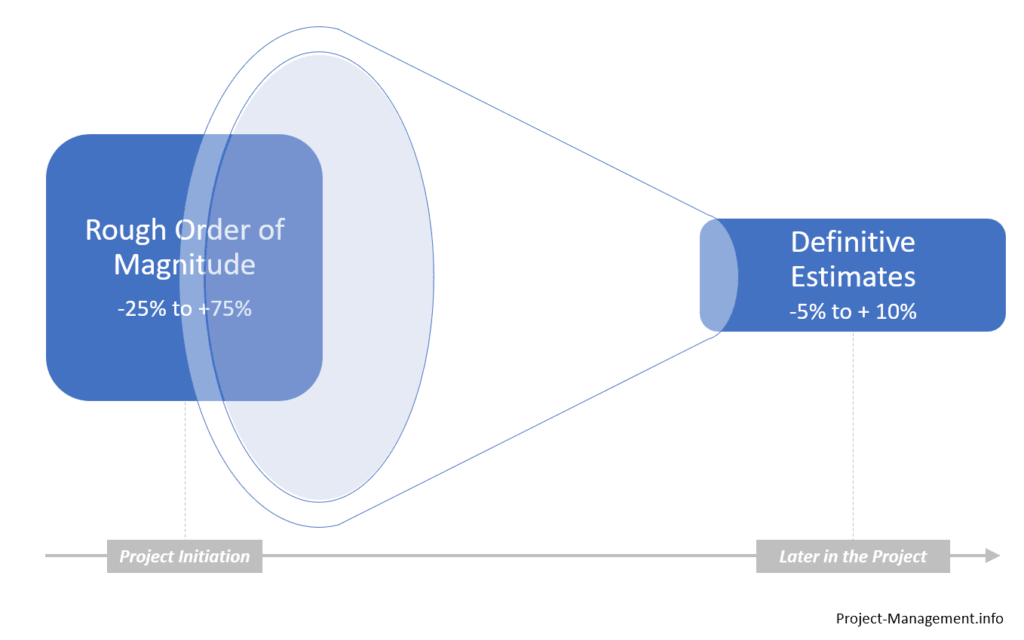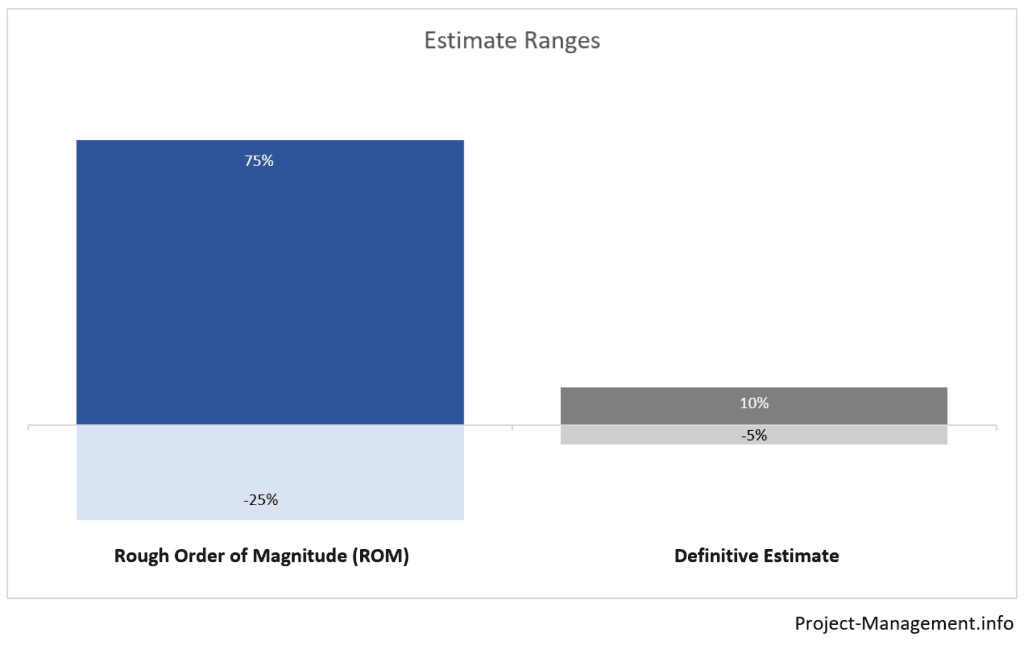During the project initiation phase (or when you are preparing for a project management exam) you will likely come across the term rough order of magnitude (ROM). The PMI’s Project Management Body of Knowledge refers to the rough order of magnitude as an initial estimate in the “estimate cost” process (source: PMBOK®, 6th edition, part 1, ch. 7.2). As the book does not elaborate on the details of the ROM, you might be wondering how it is defined and determined – especially as it is relevant for the PMP exam. The short answer is:
Rough order of magnitude (ROM) refers to an initial estimate of the cost of a project or parts of a project. It has an expected accuracy of -25% to +75% according to the PMBOK (other sources suggest -50% to +50%). In other words, the actual costs of a project are typically expected to be between 75% and 175% (or 50% to 150%) of the ROM estimate. While the calculation is straightforward, the main challenge is rather how to determine the estimate during the initiation phase of a project.
Read on to learn more details and background. If you wish to calculate the ROM range for an initial estimate, use this free ROM calculator.
What Is the Rough Order of Magnitude (ROM)?
The rough order of magnitude (ROM) is a type of cost estimate that is used in various kinds of projects. These include but are not limited to strategy development and implementation projects, IT projects as well as construction projects. It is typically used in the preparation and initiation phases of projects for the development of a project business case, for instance, or for the determination of the required financial resources that are stated in the project charter.
The purpose of a ROM estimate in project management is to provide stakeholders and decisionmakers with a rough idea of the project cost’s order of magnitude, e.g. whether an endeavor will require $1 million or $10 million (source).
The accuracy of ROM estimates is -25% to +75% according to the PMBOK (source: PMBOK®, 6th edition, part 1, ch. 7.2). Other authors set the range at +/-50% which can be used as an alternative in practice if the estimate is deemed conservative.
Note: If you are learning formulas for a PMI exam you should stick to the PMBOK and memorize the accuracy range of -25%/+75%.

To narrow this wide range of possible outcomes down, this rough cost estimate is expected to be refined in the course of the project as more information and better estimates can be obtained over time (similar to the concept of progressive elaboration).
It shall then be replaced with a so-called definitive estimate that is much more accurate (see below section on the differences between both estimates).
How Is the ROM Determined?
The calculation of the rough order of magnitude range is relatively straight forward. The formulas for the calculation of the upper and lower boundaries are as follows:
Upper Boundary = ROM_Estimate x (1 + 75%) = ROM_Estimate x 1.75;
Lower Boundary = ROM_Estimate x (1 – 25%) = ROM_Estimate x 0.75.
In practice, the more challenging part is usually to come up with the ROM estimate (i.e. the basis for the ROM range) rather than calculating the boundaries of that range. It can be determined using established estimation techniques such as analogous or parametric estimates.
As the ROM is typically used for projects in the initiation phase with a high level of ambiguity and uncertainty with respect to the expected cost, the required input data for these techniques may not be available though. The same holds true for the option to involve subject matter experts: they might not be assigned or available for bottom-up estimating at the time of a project’s initiation.
The initial estimate is therefore often based on high-level expert judgment, sometimes in conjunction with three-point estimating.
What Is the Difference between Definitive Estimate and Rough Order of Magnitude?
There are three key differences between the ROM and the definitive estimate:
- the level of accuracy,
- the project phase in which the estimate is determined, and
- the available estimating techniques.
While the ROM comes with an accuracy of -25% to +75%, the definitive estimate is much more accurate. According to the PMBOK®, it has a range of -5% to +10%.
This is because the rough order of magnitude is typically determined in the initiation phase of projects (or parts of projects) when information that is required for proper estimating tends to be vague. Resources, as well as data, may also be limited. The definitive estimate, on the other hand, is calculated in subsequent project phases when these constraints are broadly resolved.
Thus, the definitive estimate can be computed using more accurate estimation techniques, such as bottom-up estimation or parametric estimates. Both may not be available at the time the ROM estimate is determined.
Conclusion
The rough order of magnitude estimate is a rather inaccurate type of project cost estimate. However, it is typically used in the initiation phase of a project when the available information and resources do not suffice to produce better estimates.
In this situation, the ROM provides at least a rough idea of the cost range of projects which is often useful for the purpose of stakeholder communication in an early stage. The ROM estimate can also be used to develop a project business case or a project charter, for instance.
If you wish to learn more about cost and time estimating, read our guide to estimating costs take a look at our other articles on this topic.


